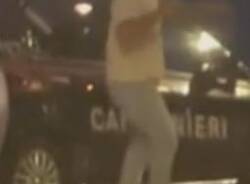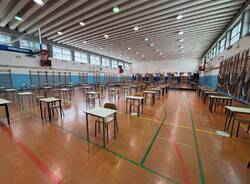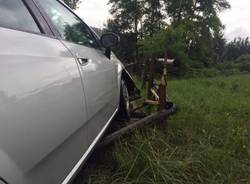The useless city: the abandoned places still waiting
From April 2010 the "Last Mohicans" tried to occupy disused areas in the Gallaratese area three times. After a few years, we went to see what happened to the buildings and what are the conditions.

Everything had happened in a year, between April and December. Three attempts of occupation, in three disused buildings, large ex-industrial areas or smaller buildings: in 2010 between Gallarate and surroundings there was the ghost of the “Last Mohicans”.
A dreaded anarchist group that wanted to set up a social center but which also claimed the contestation of urban planning choices: they wanted a space to “reflect about the theme of the exploitation of the territory”, at a Carnival parade they also invented a desecrating and chaotic allegorical chariot of the city of cement.
Beyond the way in which the problem was raised, what happened to the buildings that had been occupied? So – everything began in April, in fact – the sudden occupations and the evictions started a bit of a debate, regarding the future of those useless places that are the brownfields, left in degradation waiting for the right moment for investment, a quadrature in the circle of different real-estate interests, a market recovery.
So, let’s start from the former FS workshops of Gallarate, via Pacinotti, Madonna in Campagna district, where the occupation was “lightning”, short-lived. The sheds (partly historical buildings dating back to 1905) were abandoned for thirteen years, today twenty. In fact, the large complex has also become a makeshift home: there have been countless evictions, there has been some fires, a homeless man has died. The variant of the center-left Pgt of Gallarate had hypothesized a repurposing of the area with different functions (while stopping the construction on “virgin” terrains), but the intention clashed with the times of the owner, which were excessively long, the FS Group, which also in other contexts have shown that they want to maximize the gain on their properties (acquired a century ago, for the collective interest, it should be remembered).
Meanwhile, the FS also semi-demolished the interiors of some buildings of the complex, to make them “uninhabitable” for the homeless. And now? In the variant route hypothesized by the center-right, the importance of the “regeneration” of disused railway areas is reiterated, there was a meeting of Legambiente with the participation of the real estate managers of the FS Group, but for now there is still no concrete hypothesis.
At the end, in Via Pacinotti, little has changed. Returning to 2010, after the attempt in April, the “Mohicans” returned in October. This time moving into a different context: the village of Cardano al Campo, where they occupied a large building overlooking the hill, once a luxurious ballroom and then a dance-room.
This was to be place where they remained the longest, 16 days, and their final eviction from the place took the combined efforts of dozens of agents. The building was well known to the locals (the “San Pedar” used to be a popular meeting spot once) and stands in an area – the side of the hill facing towards the moor and Malpensa – full of abandoned buildings and unkept gardens. Many people in that neighbourhood had frowned at the prospect of having punk concerts held at their doorstep, many condemned the whole thing, but others had harboured hope that the occupation of the building could have led to the end of the state of abandon of the area: more than in the ideals of the revolution, some of the locals hoped in the liberation from the pests living in the weed-infested gardens.
Mario Aspensi, in his role of town mayor as he was at the time of the facts, reminded the local population that the owner of the building had a recovering plan for it, the “case” created some friction inside the ranks of the moderate left wing government of the town: the leading majority, belonging to the party of Casa del Popolo, although declaring itself in disagreement with the methods employed, wrote that the occupation of the building raised “a wide range of questions and problems” on “areas dedicated to young people, the usage of land, the overbuilding not only in Cardano but in the whole area surrounding Gallarate.” (In Cardano were already erected many building which are now still vacant) After six years nothing has changed, as confirmed by the words of the current mayor, Angelo Bellora. “On the contrary, there have even been a small landslide, nothing serious but enough to reveal that the area has degraded a bit.”
After a weak attempt to re-enter the “san Pedar” at the end of October, the last occupation of the “hot 2010” happened in December and was immediately stopped in its track by the police and town authorities and resulting in charges brought up against twenty-one people. In that instance the anarchists occupied the former Stere manufactory on the access-route to Cardano from Gallarate. The factory consists in a wide block including both houses and office buildings standing in front of the warehouses. The place is still a brownfield site today and nothing has changed which is visible from the outside.
However, something important but invisible has since happened to the former Stere industrial site: the situation used to be frozen because of a lawsuit for bankruptcy opened by the Busto Arsizio tribunal, but in February 2018 was sold at an auction to a local estate agency. “We have already get together for a meeting, they will present to us a project which we will consider from an urban standpoint,” says mayor Bellona. “The Territorial Management Plan includes a housing development, half reserved for the free building industry and half reserved for partnership or social housing. The terms for this are however still to be defined.” The acquisition of the former Stere is still to be confirmed, but – regardless of what to do with it in the future – there is without a doubt a positive aspect: “We have been told that their first step would be to removal of all the asbestos concrete, which will be an important improvement.”
The paradox in common with all the building that were occupied is that all three of them are sited in areas relatively close to the town centres of either Gallarate or Cardano which are still waiting for a requalification plan even after both town went through years of urban growth, with all new district built on once undeveloped areas in the town outskirts. And where the “Mohicans” had the revolution as an objective, a problem which could be solved with mere moderate reforms stands unchallenged: allow the cities and towns to grow without occupying more land, salvaging the brownfields, solving environmental problems and building a more sustainable city. All in all, such things could already be considered revolutionary, at least in Italy.
TAG ARTICOLO
La community di VareseNews
Loro ne fanno già parte
Ultimi commenti
Roberto Ganna su Elsa Fornero a Varese: “Abbiamo tolto futuro ai giovani. Ora dobbiamo restituirglielo”
Baffetta su Elsa Fornero a Varese: “Abbiamo tolto futuro ai giovani. Ora dobbiamo restituirglielo”
Fabrizio Tamborini su Elsa Fornero a Varese: “Abbiamo tolto futuro ai giovani. Ora dobbiamo restituirglielo”
Alessandro Zanzi su Elsa Fornero a Varese: “Abbiamo tolto futuro ai giovani. Ora dobbiamo restituirglielo”
Emanuele Zanetti su Motociclista di Ferno ucciso da un orso in Romania
GrandeFratello su Superate le 700 firme per la petizione sul recupero del Grand Hotel Campo dei Fiori di Varese
















Accedi o registrati per commentare questo articolo.
L'email è richiesta ma non verrà mostrata ai visitatori. Il contenuto di questo commento esprime il pensiero dell'autore e non rappresenta la linea editoriale di VareseNews.it, che rimane autonoma e indipendente. I messaggi inclusi nei commenti non sono testi giornalistici, ma post inviati dai singoli lettori che possono essere automaticamente pubblicati senza filtro preventivo. I commenti che includano uno o più link a siti esterni verranno rimossi in automatico dal sistema.